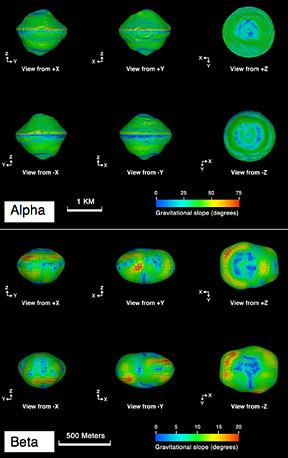|
|
Binary Asteroids
Dec
16, 2008
What
causes asteroids to split apart?Scientists have been studying small planetoids called Near Earth Objects (NEO)
for the past thirty years. Some concerns have arisen about whether large space
rocks could strike our planet since current theories suggest that one of them
caused the extinction of the dinosaurs. The Earth has supposedly been struck
many times by asteroids and comets, so astronomers have been tracking as many
objects as they can find to see if any of them cross the plane of Earth's orbit.
As the catalog of objects has increased, about 15% of the asteroids discovered are
binary. That is, they are two objects orbiting one another around a common
center of mass. A
recent press release announced that such pairs could result from the effects
of sunlight causing an increase in the spin-rate of an asteroid. Since they are
said to be loosely compacted "rubble piles", the angular momentum on the equator
increases to such a degree that loosely conglomerated rocks are thrown out of
the mass and form another loosely compacted rubble pile in orbit about the
first.
In the image at the top of the page, Asteroid 1999 KW4 Beta is thought to have
been thrown out of its parent, Alpha, because of the notable equatorial ridge
that surrounds the asteroid. It resembles a much smaller version of Saturn's
moon Iapetus – and in fact has a lenticular shape reminiscent of another moon,
Atlas.
Of course, the rubble pile
theory of asteroid composition was created to help explain
the mass anomalies that have been seen in asteroid crater
studies and in such experiments as Deep Impact, along with
the regolith migration found on Itokawa and Eros. Because
the gravity on asteroids is minute, what looks like banding,
landslides and layering of surface rocks has been theorized
to be from micro-meteor impacts shaking the asteroids. Over
long periods of time, the shaking sorts the materials by
size and density in the same way that a jar of sand and
pebbles will sort itself when it is shaken.
Some asteroids (and moons) have craters that should have
shattered them into fragments when they were hit by whatever
took away one third of a hemisphere or punched a hole more
than halfway to the other side. The only suitable
explanation, according to gravity-based models of asteroid
behavior, is that they are loosely compacted; when they are
hit by other large objects they act like big sand piles and
absorb the impacts without shattering. They have no hard
crust to begin with so they haven't fractured despite
repeated pounding.
The electric model of asteroid formation does not require
that one body crash into another one for there to be
craters. Electric arcs have the ability to cut surfaces,
scoop out material and then accelerate it into space,
leaving clean cuts, deep pits and chaotic topography. The
effect is commonly called electric discharge machining (EDM).
Comets also exhibit surface features that are the same as
what has been seen on asteroids, leading Electric Universe
theorists to speculate that the two are really one thing and
not "dirty snowballs" vs. rocky bodies.
If the electrical stress does become too great within an
asteroid – when it enters the magnetosphere of a planet like
Earth, for instance, it may explode into tiny fragments that
burn up. If the electrical stress is not too great as an
asteroid flies through another e-field it might split into
two large pieces instead of exploding. The same equalization
of potential could take place but leave behind a pair of
orbiting twins that continue on their way.
A theory of electrical fissioning might provide a more
reasonable hypothesis than sunlight and angular momentum,
although the sunlight theory has the advantage of acceding
to the billion-year timescale that dominates science today.
Everything takes so much time that the numbers no longer
have meaning and is relegated to a past so remote that it is
unimaginable. To say that sunlight requires a billion years
to spilt an asteroid is science; yet saying that a bluebird
can do it is a myth. But given a billion year old bluebird,
who knows?
People are typically uncomfortable with events that happen
quickly in a large frame of reference. Floods, earthquakes
and lightning are frightening and unpredictable when they
take place on the scale of cities and counties. No one wants
to imagine that such things could take place on the
planetary or stellar scale. However, each of the phenomena
that we consider in these pages interrelate in ways that
make the conclusion compelling: electricity forms most of
what we see in the Solar System and beyond.
By Stephen Smith
|
|
|
|
|
|
SPECIAL NOTE - **New Volumes Available:
We are pleased to announce a new
e-book series
THE UNIVERSE ELECTRIC. Available now, the first volume
of this series, titled Big Bang, summarizes the failure of modern cosmology
and offers a new electrical perspective on the cosmos. At
over 200 pages, and
designed for broadest public appeal, it combines spectacular
full-color graphics with lean and readily understandable
text.
**Then second and third volumes in the series are now available,
respectively titled Sun and Comet, they offer
the reader easy to understand explanations of how and why these bodies
exist within an Electric Universe.
High school and college students--and teachers in
numerous fields--will love these books. So will a large
audience of general readers.
Visitors to the Thunderbolts.info site have often
wondered whether they could fully appreciate the Electric
Universe without further formal education. The answer is
given by these exquisitely designed books. Readers from
virtually all backgrounds and education levels will find them
easy to comprehend, from start to finish.
For the Thunderbolts Project, this series is a milestone.
Please see for yourself by checking out the new
Thunderbolts Project website, our leading edge in
reaching new markets globally.
Please visit our
Forum
|
|
|
|
|
|
|
|







